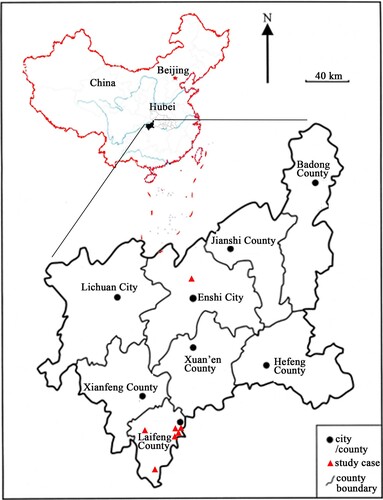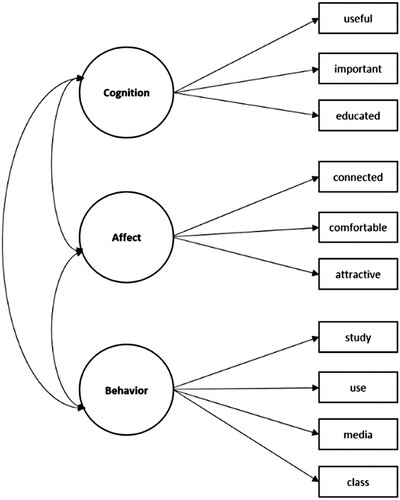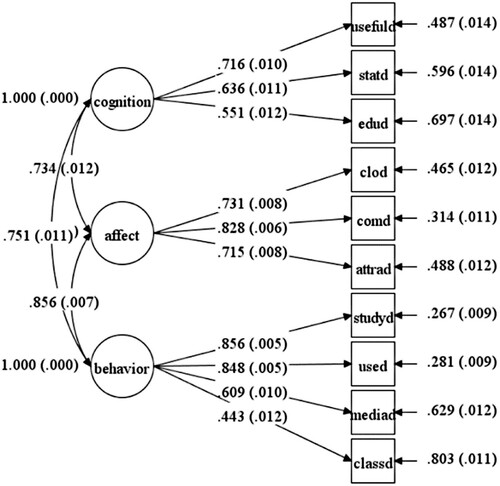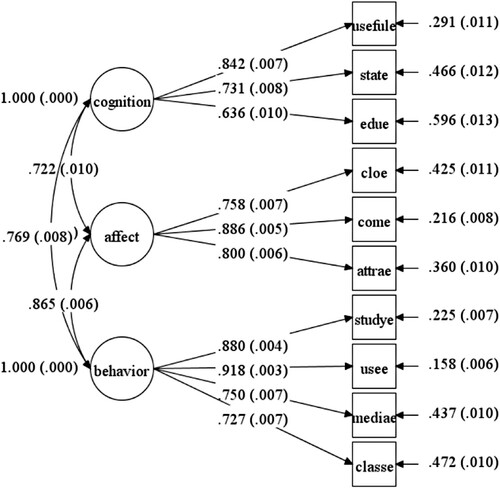ABSTRACT
The article reports on the development and validation of a new scale for assessing attitudes towards multiple languages among multilingual students from Enshi Tujia and Miao Autonomous Prefecture, China. The Language Attitudes Scale-Student Form (LASS) was developed based on relevant theory and literature as well as interview data from four students and four language teachers. The LASS consists of 40 items, with ten measuring students’ attitudes towards their dialect, ethnic (minority) language, Putonghua, and English, respectively. The LASS was validated among 5,237 students of seven schools from the elementary level to the tertiary level. The participants were mainly from Han (n1 = 1,827) and two ethnic minority groups of Tujia (n2 = 2,242) and Miao (n3 = 886). The traditional triadic (cognition-affect-behaviour) model of language attitudes was generally supported across ethnic groups, languages, and educational levels. A series of validity tests and reliability tests were conducted, showing that the LASS was psychometrically sound. In addition, the predictive effects of language attitudes in self-perceived language proficiency and real language achievement were also confirmed to a large extent, highlighting the need to include language attitude as an important individual difference factor for language learning.
Introduction
Language attitude is an important construct extensively studied in sociolinguistics for its important role in identity construction, language maintenance, bi/multilingualism, language planning and policy, to name a few areas (Garrett Citation2010; Salmon and Menjívar Citation2019). It has long been considered to be a triad of cognitive, affective, and behavioural components (Dragojevic Citation2016; Garrett Citation2010). However, the long-held tripartite model remains to be empirically and statistically supported across groups and language varieties. We thus raise the central issue concerning its conceptualisation: What is language attitude and what is the underlying structure?
Language attitude has been assessed using a wide range of methods. Likert scales have been popular in language attitude research mainly for their convenience and accessibility to participants. However, little is known about the development and validation process of extant measures for language attitude. We thus raise the second issue concerning its measurement.
Language attitude has been argued as an important factor influencing L2 (second language and foreign language) learning (Artamonova Citation2020; Salmon and Menjívar Citation2019). In contrast with sociolinguistics research, in the field of second language acquisition (SLA), language attitude has not been captured sufficiently in its own right. Instead, it has been attended to only as an integral part of motivation (Artamonova Citation2020; Gardner Citation1985a, Citation1988a; Gardner and Lambert Citation1972; Masgoret and Gardner Citation2003). It remains to be explored what is the underlying structure of an individual’s attitude toward his or her target L2. In addition, although argued as an important construct in SLA (Artamonova Citation2020; Salmon and Menjívar Citation2019), there is little empirical evidence for whether and how an individual learner’s attitude towards L2 contributes to his/her L2 achievement, which is of central importance in SLA research. The language attitude-achievement link is the third issue we raise.
To address the three issues raised above, we developed the Language Attitudes Scale-Student Form (LASS), cross-validated it among multilingual students, and applied it to examine language attitude-language achievement links. The participants of the current study were from Han, Tujia, and Miao ethnic groups at different educational levels (from the elementary to the tertiary educational level) from an ethnic minority autonomous prefecture in China. The languages (varieties) involved were their dialects, ethnic (minority) languages (i.e. the Miao and Tujia languages), Putonghua, and English.
Language attitudes: construct and scale measures
In line with the tripartite model of attitudes in social psychology, language attitudes are generally defined as a set of beliefs, feelings, and behavioural intentions towards different language varieties (Dragojevic Citation2016). Likert rating scales have long been used to measure language attitudes (Soukup Citation2013) and the following concerns can be summarised. Firstly, although many studies have adopted the tripartite definition of language attitude, the scale measures do not represent the conceptual structure correspondingly. That is, there is a discrepancy between conceptualisation and measurement of language attitude. Secondly, regarding scale development, there has been an overall lack of transparency. For example, what are the sources for the generation of item pools? (Bourhis Citation1983; Dewaele et al. Citation2018; Qu Citation2017; Xie and Cavallaro Citation2016). How are the items developed or modified? (Ng and Zhao Citation2015; Yang Citation2016). Rezaei, Latifi, and Nematzadeh (Citation2017) is an exception that has provided the development process relatively transparently. However, the psychometric properties were not assessed or at least not reported. This leads to our third concern about the validation of language attitude measures: To what extent are the extant scale measures valid and reliable? As mentioned, language attitudes have been defined as a three-factor construct. However, it is surprising that few empirical studies have statistically validated the prior theoretical model using confirmatory factor analysis or other alternatives. In addition, a considerable number of empirical studies have applied certain scale measures to examine the profiles of language attitudes of certain groups without reporting any psychometric properties of the measures (e.g. Li Citation2022; Ng and Zhao Citation2015; Qu Citation2017; Xie and Cavallaro Citation2016; Yang Citation2016). However, ideally, the following validity and reliability should be assessed for newly-developed scales: Construct validity, discriminant validity, convergent validity, criterion validity, predictive validity, internal consistency, and item-total correlation (Dörnyei and Dewaele Citation2023).
Of note, there are a few studies that have reported the construct validity of language attitude scales and thus described the underlying structure of language attitude. For example, Ting and Puah (Citation2015) revealed different factors of language attitudes among Foochow (n = 150) and Hokkien (n = 150) participants in Malaysia using exploratory factor analysis (EFA). The four factors for Foochow participants were: (1) Instrumental value of Chinese languages, (2) embarrassment for not speaking Chinese languages, (3) Chinese dialect as ethnic marker, and (4) reasons for importance of Chinese dialect. For Hokkien participants, another two factors were obtained, namely, (5) importance of Mandarin for children and (6) Mandarin ability and use. The limitation is apparent: all the factors (except Factor 3 and Factor 4 for Hokkien participants) were assessed with only two items. However, psychometrically, a factor should be assessed with at least three items (Hair et al. Citation2010). Furthermore, the factor structures identified do not support the tripartite model of language attitudes. In another study by Bekker (Citation2004) (n = 100) based in South Africa, a three-factor model for language attitudes was obtained using EFA: (1) Domain-specific practical issues, (2) a generally negative or positive attitude towards English, and (3) the presence or absence of an integrative attachment to the African languages. The finding also refutes the traditional tripartite model of language attitudes. In a recent study, Wei, Jiang, and Kong (Citation2021) developed and validated a 12-item scale, with four items measuring attitudes towards the ethnic language, Putonghua, and English, respectively. The validation was conducted among 310 Chinese Mongolian university students. Although exploratory factor analyses (EFAs) were used to explore the factor structures, there were no further confirmatory factor analyses (CFAs) to confirm the structures. In addition, only four items were used to assess attitude towards a certain language, leaving the conceptualisation of language attitude a challenge. In another recent study, Artamonova (Citation2020) developed and validated a 28-item Language Attitude Questionnaire based on the data of 127 Spanish majors in the US. A three-factor model was obtained using principal component analysis (PCA): (1) Attitudes toward multilingualism, (2) attitudes toward language learning, and (3) attitudes toward Spanish. The three-factor model statistically supported was also incongruent with the classic triadic model although the triadic model was used as the theoretical framework.
The four studies converge to show that people from different linguistic groups may have different conceptualizations of language attitudes, necessitating the current inquiry. Although the four studies have their strengths in that they reported the construct validity and reliability, the following weaknesses are apparent as well. Firstly, the sample sizes were relatively small for scale validation. Secondly, the statistical methods used to check the construct validity or the underlying structures of language attitudes were problematic or at least not sufficient. For all the studies, CFA should be further conducted to confirm the structure obtained in the EFA family including PCA. Alternatively, CFA should be performed directly instead of EFA or PCA in those studies where the scales were developed based on a priori hypothesised three-factor model (Kline Citation2010). In other words, although the classic triadic model of language attitudes has been widely agreed on by sociolinguists, it has not yet been sufficiently or statistically corroborated. It is thus necessary to cross-validate the theoretical model among different groups of language learners and users. Thus, in the present study, we seek to testify the tripartite model by cross-validating it among students at different educational levels from different ethnic groups.
Language attitudes and language achievements
Attitude towards language has long been recognised as a crucial factor in the process of learning and teaching a language (Saeed et al. Citation2014; Smith Citation1971). As Huguet (Citation2006) argued, ‘language learning will rarely occur if subjects do not show positive attitudes to the language in question and the lessons where it is taught’ (p.414). This may be explained by the four-step formation of student language (learning) attitude (Smith Citation1971). The first step is the cognitive process: a student perceives and develops a concept of a language and the language class. Then, there is the affective process: The student develops certain feelings (excitement, happiness, confidence, adequacy, boredom, frustration, anger, and inadequacy) in response to their perceptions of the language and language class. The next step is the evaluation of these feelings. Lastly, the evaluations are translated into certain behaviours. In other words, the student behaves in accordance with his or her attitudinal evaluations of the language and language class. This indicates that language attitude is acted out as learning behaviour, which is a determinant of scholastic achievement (Schaefer and McDermott Citation1999). In addition, Smith (Citation1971) also pointed out that language attitude is linked to motivation (instrumental or integrative) and emotion (positive or negative), both of which have been evidenced as significant factors of language achievement (Botes, Dewaele, and Greiff Citation2020; Li and Wei Citation2022; Masgoret and Gardner Citation2003). All these point to the potentially important role of language attitudes in affecting language learning outcomes at the conceptual level.
In the case of second or foreign language (L2) learning, research on attitudes towards language has been greatly influenced by Gardner’s (Citation1985b) classic theoretical model. In the socio-educational model, attitude towards the language learning situation and intergrativeness are two attitudinal factors that are influenced by cultural beliefs and influence motivation. Motivation interacts with language attitude in formal or informal language acquisition contexts to influence linguistic or non-linguistic outcomes. The ambiguity is apparent between motivation and attitude at the conceptual level in this model. In addition, as operationalised in the Attitude and Motivation Test Battery (Gardner et al. Citation1979), attitudes towards target foreign language (FL), FL users, FL teachers, and courses are measured as factors of integrative motive along with other motivation constructs. The concept, measurement, analytical or methodological confusions may explain why relevant results obtained from research on attitudes and motivation and L2 learning outcomes are ambiguous or inconsistent (Au Citation1988; Gardner Citation1988a, Citation1988b). In a meta-analysis (k = 51) (Masgoret and Gardner Citation2003), attitudes towards the language learning situation were found to be significantly related to three different achievement measures, i.e. grades (r = .24), objective measures (r = .17), and self-ratings (r = .26).
Taking together, the current study seeks to provide evidence for the language attitudes-language achievements based on psychometrically sound measures of attitudes towards different languages in accordance with a clear definition and operationalisation of language attitudes.
The current study
The following gaps can be summarised based on the review of previous language attitudes studies. Firstly, language attitudes have been conceptualised and measured distinctively in the two lines of sociolinguistics and SLA research. This makes attitudes towards multiple languages (varieties) of the same groups of learners within a given society incomparable due to a lack of consistent conceptual structure and measurement. This may also block the integration interface for language attitudes between sociolinguistics and SLA research. Secondly, in SLA research, language attitudes have been examined as a component of motivation rather than in their own rights, which has led to the confusion or interchangeable use of the two concepts and ambiguous results. Thirdly, there is an inconsistent picture concerning the link between language attitudes and language achievements. To these ends, the present study seeks to (1) investigate how the same group of people conceptualise attitudes towards multiple languages (standard and nonstandard language varieties and L2), (2) develop and validate a psychologically sound measurement for language attitudes across languages, and (3) examine the links between language attitudes and language achievements. Specifically, the study focused on Han, Tujia, and Miao students from the elementary to the tertiary level in Enshi Tujia and Miao Autonomous Prefecture in Hubei Province, China, examining their attitudes towards their ethnic languages, dialects, Putonghua, and English. Correspondingly, the study was guided by the following research questions (RQs):
RQ1: What are the underlying structures of Han, Tujia, and Miao students’ attitudes towards their ethnic languages, dialect, Putonghua, and English?
RQ2: How valid and reliable is the Language Attitudes Scale-Student Form (LASS) across the above-mentioned ethnic groups and languages?
RQ3: How are language attitudes connected to language achievements?
Methodology
The local context
Convenience sampling was adopted. Enshi Tujia and Miao Autonomous Prefecture (hereinafter referred to as ‘Enshi’) was chosen as the research site of the current large-scale study for the following reasons. Firstly, it is an autonomous prefecture home to about 30 ethnic groups including Han, Tujia, Miao, Hui, Dong, Mongolian, Yi, and Zhuang, among others. However, this multi-ethnic, multi-lingual, and multi-cultural context has been relatively under-explored. Secondly, it is the only autonomous prefecture in Hubei province of central China where the first author is based in and has access to in data collection. It is located in a mountainous corner of southwestern Hubei, bordering Xiangxi Tujia and Miao Autonomous Prefecture, Hunan province in the south, and Chongqing Municipality in the northwest (see ). It has a total area of about 24, 000 square kilometres with a population of about 3.8 million. More than half of them belong to Tujia and Miao minorities. It was also home to ten impoverished counties until April 2020.
There are three active languages (forms) used in Enshi, namely the mainstream national language (Mandarin), Enshi dialect (particularly in life domains), and English (particularly in the education domains). Minority languages have been challenged, and Enshi government has issued a series of policies to vitalise them including promoting their visibility on public signage (see Appendix 1) and in cultural activities (e.g. such as the Baishou Dance, literally ‘hand-waving dance', which is the ethnic dance of Tujia; folk game songs; see Appendix 1). Minority language course (e.g. Tujia ethnic language, see Appendix 1) is also provided in minority ethnic schools like BFS in our current study (see ).
Table 1. Participants and participating schools/university.
Participants
Participants in the preliminary interview were four elementary students (n = 4) from two schools in rural and urban Enshi and their Chinese (n = 2) and English teachers (n = 2). Participants in the main questionnaire survey were 5,237 students from two elementary schools, four secondary schools, and an ethnic university in Enshi. Only the university is located in central Enshi, while other schools are located in Laifeng, a county in southwestern Enshi. The numbers of students at the elementary level, the secondary level, and the tertiary level were 665 (12.70%), 3,701 (70.67%), and 871 (16.63%), respectively (see for more information). The numbers of students from Han, Tujia, Miao, and other minority ethnic groups were 1,827 (34.89%), 2,242 (42.81%), 886 (16.92%), and 282 (5.38%), respectively. The detailed demographic characteristics (i.e. ethnicity, educational level, school, gender, and age) of the participants are displayed in . A total of 4,355 (83.15%) participants were studying in urban areas including two private boarding secondary schools whose students were originally from both rural and urban areas. The rest 882 (18.75%) participants were from two schools in rural areas, and 75.51% of them (666 out of 882) were left-behind children. Specifically, 38.3% of them (338/882) lived with neither of their parents, both of which worked in distant urban areas, 29.2% of them (259/882) lived with their mothers, and their fathers worked in distant urban areas, 7.8% of them (69/882) lived with their fathers, and their mothers worked in distant urban areas, and only 24.4% (216/882) of them were not left-behind children and lived with both their parents. As for the language tests, 4,026 of the 4, 366 non-university questionnaire participants were the examinees.
Instrument
Instruments in the study were interview questions in the preliminary study and a composite questionnaire and language tests in the main study. The composite questionnaire consisted of three sections for demographic information, the Language Attitudes Scales-Student Form (LASS) (for ethnic languages, dialect, Putonghua, and English), and self-perceived language proficiency, respectively.
Preliminary interview
Semi-structured interviews were conducted with elementary students and their English and Chinese teachers. The guideline questions were structured along the three theoretical components of language attitudes, namely cognition, affect, and behaviour related to dialect, Putonghua, minority languages, and English. Example questions for the three components are (1) How do you feel about the utility/status of your ethnic language/dialect/Putonghua/English? (the cognitive dimension of language attitudes) (2) What’s your feeling towards your ethnic language/dialect/Putonghua/English? (the affective dimension of language attitudes), and (3) When do you expect the use of your ethnic language/dialect/Putonghua/English in your life? (the behavioural dimension of attitudes).
Language attitudes
We developed the LASS on the theoretical tripartite model of attitude (i.e. Cognition, Affect, and Behaviour) rooted in social psychology (Eagly and Chaiken Citation1993; Zanna and Rempel Citation1988) as well as sociolinguistics (Cooper and Fishman Citation1977; Garrett Citation2010). The items were generated based on the following sources: (1) The interview data collected in the preliminary interview, and (2) items of extant relevant instruments (e.g. Artamonova Citation2020; Ng and Zhao Citation2015; Qu Citation2017). The interview data were qualitatively analyzed to obtain themes as indicators used in the generation of the LASS. For example, the expression of ‘educated’ in the scale item was taken from ‘ … the use of English makes me feel myself being better-educated … ’ reported by a student participant.
A parsimonious pool of ten items was determined after experts’ judgment. Three items were used to measure the cognitive dimension, three for the affective dimension, and four for the behavioural dimension (see for the visualised conceptualizations of language attitudes). The items were arranged on a 7-point Likert scale indicating a continuum from a very negative attitude to a very positive attitude, for example, from 1 ‘absolutely useless/unimportant’ to 7 ‘extremely useful/important’ (see for the scale concerning different languages as well as its sources).
Intended effort
Considering that attitudes have been examined as part of the motivation in L2 research (Artamonova Citation2020), the intended effort was chosen as a criterion measure in the current study. Taguchi, Magid, and Papi’s (Citation2009) six-item scale, traditionally used in L2 motivation research, was utilised to measure participants’ intended efforts in the languages under discussion. The Cronbach’s alphas were .897 (English) and .877 (Putonghua), respectively.
Language achievements
Language achievements were used as outcome variables to assess the predictive validity of the LASS (RQ3, see Data analyses for more details). Following the practice in scale development and validation literature in applied linguistics (e.g. Teimouri, Plonsky, and Tabandeh Citation2022), language achievements were operationalised as self-perceived proficiency in different languages (dialect, ethnic language, Putonghua, and English) and final exam scores (Chinese and English). Four items were adopted to assess self-perceived English and Putonghua proficiency in listening, speaking, reading, and writing, following Li (Citation2020), while two items concerning listening and speaking were for dialect and the minority languages. The items were arranged on a 7-point Likert scale from 1 ‘very poor’ to 7 ‘very excellent’. The mean scores of the responses to the four items were used as indicators of self-perceived language proficiency levels. The Cronbach’s alphas were .850, .887, .849, and .896 for dialect, minority languages, Putonghua, and English, respectively. As for English and Chinese exams, the same examination papers were used at the same instruction levels across all schools, which is a tradition in Laifeng county. This ensures that the final scores of participants from different schools were comparable.
Procedures
There were mainly four phases involved in data collection (see ): (1) Preliminary interview, (2) scale development, (3) questionnaire survey, and (4) language tests.
Preliminary interview
The preliminary semi-structured interviews were conducted in September 2020 through Wechat (a mainstream messaging and calling App in China). The teacher interviewees were recommended by the school principals in the two schools in rural and urban sites. The four six-graders were recommended by the participating teachers considering their different perceived attitudes towards Chinese and English.
Scale development
We developed a ten-item LASS concerning each language under discussion based on the interview data and relevant existent measures as mentioned previously. Subsequently, three experts in sociolinguistics and applied linguistics were invited to judge the comprehensibility, accuracy, appropriateness, and readability of the LASS. Any disagreements were solved after further discussion to achieve desirable face validity.
Questionnaire survey
The questionnaire survey was conducted in December 2020. Traditional paper-and-pen questionnaires were administered to participants at the elementary and secondary levels for the following reasons: (1) the use of mobile phones was not allowed for them; (2) mobile network was not accessible in each classroom; (3) students, especially those in rural areas, may not be accustomed to answering questions on mobile devices or using computers. As for university participants, a web-based questionnaire was used.
Language exams
Chinese and English exams, as part of the final exams, took place in January 2021 in each participating school.
Ethics
For the investigation of elementary and secondary students, official approval was first obtained from the first author’s institution, then the local education authority of Laifeng County, Enshi, and its subordinate schools in June 2020. Once the school principals received the official approval from the local education authority, they assigned headteachers in different grades to assist the research team in obtaining consent from the custodians of the participants. Then, the first author, along with her research assistants administered printed questionnaires to each participating school, which were then administered to target students by their headmasters during class to ensure a higher degree of completion. The headteachers also provided the authors with participants’ scores in the final English and Chinese exams when the semester was over in January 2021. For university students, a web-based questionnaire was forwarded to the department chair of English Language in the participating university. Upon censorship, the questionnaire was forwarded to English teachers, who further administered it to their students during class time.
The nature, purpose, and approximate duration of the survey were clarified at the very beginning, followed by the clarification of participants’ rights of non-participation and withdrawal from the survey without any undesirable consequences. Considering the correlational nature of the research design in response to RQ3, the participants were required to provide the abbreviations of their names in the questionnaire survey, which were used to match questionnaire data and exam scores and removed from subsequent data analyses.
Data analyses
All the data collected in the main study were digitalised and then checked for the issue of outliers using excel. Missing values were replaced with the mean scores of certain participants in the LASS using SPSS 19.0. In accordance with the first RQ, we conducted a series of confirmatory factor analyses using Mplus 8.3 to reveal the conceptual structures (also termed construct validity) of attitudes towards ethnic languages, dialect, Putonghua, and English. To address RQ2, a series of validity tests (construct validity, convergent validity, and criterion validity), reliability tests (global scale and subscales), item analysis (item variance for the discriminant validity of items), and correlation analyses (item-total correlation for item communities) were conducted to assess the psychometric properties of the LASS. Regarding RQ3, a series of correlation analyses were conducted to examine language attitudes-language achievements links. The links between the target psychological variable and its learning outcomes could also be termed as predictive validity in psychometric assessment (Teimouri, Plonsky, and Tabandeh Citation2022).
Results
The following section presents results in connection with the three RQs.
Conceptual structures of attitudes towards different languages
Considering that the LASS was developed based on a prior theoretical model, namely the tripartite of cognition, affect, and behaviour, we conducted CFA rather than EFA (Kline Citation2010) to verify the proposed conceptual model. We performed rounds of CFA using the data of language attitudes retrieved from different ethnic groups towards different languages. The CFA results are presented, more specifically, model fit indices and factor loadings of all items. Fit indices used are χ2/df, p, RMSEA, CFI, TLI, and SRMR, and their cut-off values for acceptable model fit are χ2/df (subject to sample size), CFI>.90 (Kline Citation2010), TLI>.90 (Kline Citation2010), SRMR < .08 (Hu and Bentler Citation1999), and RMSEA < .10 (Steiger Citation1990). Regarding Chi-Square, as pointed out by Hooper, Coughlan, and Mullen (Citation2008), Chi-Square statistic is sensitive to sample size, and thus there is no consensus on its cut-off value especially when the sample size is large. Concerning RMSEA, its cutoff value is generally regarded as .08 in recent years, however, in the present study, we used the less stringent threshold of .10 as an acceptable fit because we also agree that strictly adhering to recommended cutoff values can lead to instances of the incorrect rejection of an acceptable model (Hooper, Coughlan, and Mullen Citation2008). In the current study, values above .10 indicate a poor fit, values between .08 and .10 indicate a mediocre fit, and values below .08 indicate a good fit following MacCallum, Browne, and Sugawara (Citation1996). In addition, as Brown (Citation2015) pointed out, ‘RMSEA may be of less concern if all other indices are strong in a range suggesting ‘good’ model fit’ (p.75). Most importantly, we agree that ‘while fit indices are a useful guide, a structural model should also be examined with respect to the substantive theory’ (Hooper, Coughlan, and Mullen Citation2008, 57). Taking together, the appraisal of a model is not simply based on fit indices, but also relevant theory and fact. As for factor loadings of each item, the cutoff value is .40 (Hair et al. Citation2010).
As displayed in , the three-factor model in was generally supported in the whole sample across four languages (varieties) (see Figures –). That is, language attitudes were consistently conceptualised as a three-dimensional construct: Cognition, affect, and behaviour. By contrast, a closer look at the attitudes of Tujia students and Miao students towards English shows that the tri-factor model was not sufficiently supported.
Figure 3. The conceptual structure of student attitudes towards languages. Note: T: teachers; S: students.
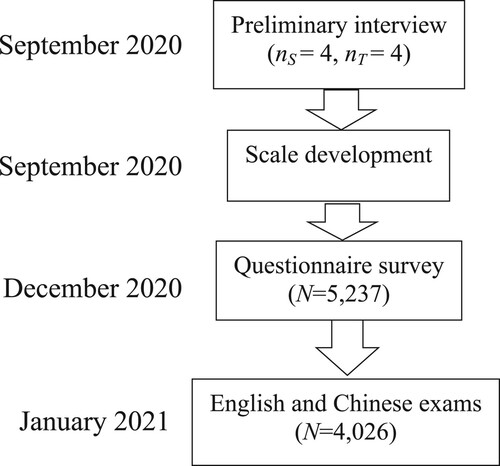
Figure 5. Attitude towards Putonghua: Factor structure and factor loadings (Whole sample: N = 5,237).
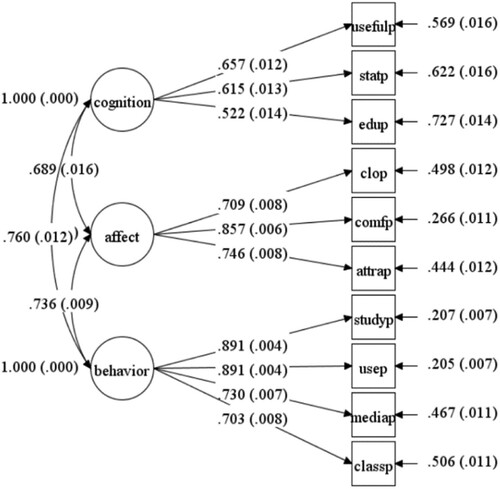
Figure 7. Attitudes towards ethnic languages: Factor structure and factor loadings (Ethnic minority participants: N = 3,410).
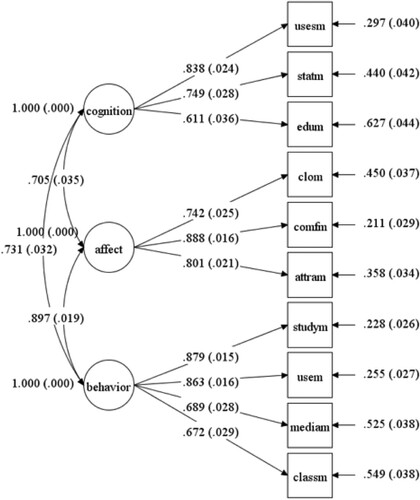
Table 2. Goodness-of-Fit Indices for the three-factor model of language attitudes.
When the data of different ethnic groups were mixed (N = 5,237), the factor loading ranges of items in the LASS for dialect, Putonghua, and English were [.443, .856], [.522, .891], and [.636, .918], respectively, all at an acceptable level (see ) (>.40) (Hair et al. Citation2010). When the data of ethnic minority groups (N = 3,410) were mixed, the factor loading range of items in the LASS for their ethnic languages was from .611 to .888 (see ).
When it comes to the Han group, the factor loading ranges of the ten items in the LASS for dialect, Putonghua, and English were [.506, .891], [.514, .909], and [.588, .911], respectively, all at an acceptable level (>.40) (Hair et al. Citation2010). As for the Tujia group, the factor loading ranges of the ten items in the LASS for their ethnic language, dialect, Putonghua, and English were [.595, .902], [.576, .918], [.519, .865], and [.316, .908], respectively. It is thus suggested to remove Item 10 (factor loading = .316) when the LASS is used to measure Tujia learners’ attitudes towards English. In terms of the Miao group, the factor loading ranges of the items in the LASS for their ethnic language, dialect, Putonghua, and English were ranges of [.611, .888], [.627, .902], [.366, .847], and [.339, .849], respectively. It is thus suggested to remove Item 3 (factor loading = .366) and Item 10 (factor loading = .339) when the LASS is used to assess Miao learners’ attitudes toward Putonghua and English, respectively. However, there were only three items in the Cognition Subscale, and thus we still kept Item 3 in subsequent analyses to make sure that the Cognition dimension was measured by at least three items (Hair et al. Citation2010).
Psychometric properties
Item analysis
We first conducted item analysis using SPSS (Wu Citation2010), specifically, independent t-tests to assess item variance, and item-total correlation analyses to assess the communities of the items. Independent t-tests were conducted between high-score groups and low-score groups at the item level. Those who scored the top 27% and the bottom 27% were created as high-score groups and low-score groups. The results show that all the items have the required discriminant validity (p<.01 level), enabling subsequent analyses. Item-total correlations were then checked. The results are displayed in . According to the criteria (r = .40) (Wu Citation2010), no item was eliminated in this process.
Table 3. Correlation between items and total scales.
Convergent validity
Convergent validity is the evidence of similarity between measures of theoretically related constructs. Composite reliability (CR) and Average Variance Extracted (AVE) are commonly used indicators of convergent validity in a reflective model. CR indicates to what extent the multiple indicators are measuring the construct the factor represents and should exceed .60 in an adequate model (Chin Citation1998). AVE indicates the average commonality for each latent factor and should exceed .50 in an adequate model (Chin Citation1998). Based on λs, factor loadings of each item obtained in previous CFAs, CRs, and AVEs were calculated automatically with the following two equations using Excel (available on IRIS database when the manuscript is accepted).
The results concerning dialect, Putonghua, and English were based on the whole sample, while the results concerning the minority languages were based on the data of the minority students. As shown in , CRs and AVEs were generally acceptable for all LASS subscales in relation to different languages, showing desirable convergent validity. However, AVEs for Cognition Subscale concerning Dialect and Putonghua were below the cutoff value of .50.
Table 4. Convergent validity of the Language Attitudes Scale-Student Form in relation to different languages.
Criterion validity
Criterion validity refers to the correlation between the measure under validation and non-incidentally but theoretically related constructs (Devellis Citation2016). The constructs of intended efforts in learning Putonghua and English were used as the criterion constructs considering their conceptual links to language attitudes. The results based on the whole sample showed significant correlations between intended efforts and attitudes towards English (r = .674, p < .001), and between intended efforts and attitudes towards Putonghua (r = .307, p < .001), indicating adequate criterion-related validity (N = 5,237).
Reliability
The reliability of the scale was assessed using Cronbach’s Alpha. The alphas for the global LASS across all languages were above .80 (see ), indicating high overall reliability. At the dimensional level, the alphas for all the three subscales (Cognition, Affect, and Behavior) in relation to different languages were above .65 (Devellis Citation2016), except the Cognition Subscales in relation to Putonghua. Further refinement could be made to this subscale.
Table 5. Cronbach’s Alphas of Scales and Subscales (N = 5,237).
The links between language attitudes and language achievements
The normality of language attitudes scores was confirmed, enabling a series of subsequent Pearson correlation analyses. The results of language attitudes-achievements links are presented in and .
Table 6. Correlations between language attitudes and self-perceived language proficiency (r ).
Table 7. Correlations between language attitudes and real achievement in languages (r).
Language attitudes and their associations with self-perceived language proficiency
As displayed in , there was an overall positive correlation between language attitudes and self-perceived language proficiency in the whole sample. The effect sizes ranged from .14 to .62, accounting for 1.96%−38.44% of variance.
Notably, for Han elementary students, no significant correlation was found between their attitudes towards Putonghua and their self-perceived Putonghua proficiency. For Han students in Grade 2 of senior secondary school, no significant correlation was found between their attitude towards dialect and their self-perceived dialect proficiency. For Miao students in their first year and second year of senior secondary education, the correlations between their attitudes towards English and their self-perceived English proficiency were insignificant.
Language attitudes and their associations with language exam scores
As displayed in , regarding English, language attitudes were generally positively linked to English exam scores across educational levels and ethnic groups except for Miao students in Senior 3. The effect sizes ranged from .25 (small-to-medium) to .63 (large), accounting for 6.25% – 39.69% of variance in English exam scores.
For Putonghua, there was a general declining tendency in the correlations between language attitudes and language achievements as the educational level grew. At the elementary level, language attitudes were positively linked to language achievement, and the effect sizes ranged from .25 to .37. At the junior secondary level, language attitudes were generally positively linked to language achievements, and the effect sizes ranged from .14 to .33. At the senior secondary level, language attitudes generally lost its correlation with language achievements except for Senior 3 Han students.
Discussion
The current study aimed to (1) clarify the underlying structure of language attitudes, (2) develop and validate an instrument to measure attitudes towards multiple languages within a given society, and (3) examine the predictive effects of language attitudes on language achievements.
Regarding the underlying structure of language attitudes, CFA results in and show that attitudes of different ethnic groups towards different languages were generally conceptualised and expressed through their cognitive, affective, and behavioural components. The results provide statistical support for the widely accepted triadic model of language attitudes, rooted in social psychology (Allport Citation1935; Eagly and Chaiken Citation1993) and sociolinguistics (Dragojevic Citation2016; Garrett Citation2010). Language attitudes are cognitive in that they involve beliefs and judgments of languages. For example, many language learners in the current study believe that Putonghua is of social significance, and English is associated with a high educational level. The affective component of language attitudes concerns the feelings about the languages and is related to the favorability and unfavourability of certain language aspects or the extent to which language learners approve or disapprove of certain language aspects. For example, some language learners feel most comfortable using their dialects, and some reported likings of their ethnic language. Language attitudes are behavioral insofar as they concern the predisposition to behave in a certain way, and perhaps in a way typically in line with cognitive and affective judgments. For example, some participants reported that they were willing to study or use a certain language in their life events. Exceptions were the occasions when the LASS was used concerning English as a foreign language among the two ethnic minority groups. The three-factor model was inadequately supported as indicated by the large RMSEAs (.12 and .16 respectively) presented in , indicating the need for further modifications in similar contexts.
Moving to the second RQ about measurement, the current study also provides a practical instrument for measuring the attitudes of students at different educational levels towards their dialects, official language (Putonghua), ethnic language (Tujia language, Miao language, etc.), and English as a foreign language. A series of reliability and validity tests of the overall scales, their subscales, and the individual items in relation to four different languages (varieties) have shown that the LASS is generally psychometrically sound. As shown in , the factor loadings of items in the scales were also satisfactory.
The LASS has apparent research value in that the same scale can be applied to bilinguals or multilinguals within a given society to measure their attitudes towards multiple languages they have acquired, enabling the comparison between attitudes towards different languages of the same group. In addition, the LASS is parsimonious with just ten items measuring the attitude towards a specific language. The parsimony allows for high feasibility, convenient administration, and easy interpretation. Pedagogically, language educators may use it as a diagnostic tool of language learners’ language attitudes (changes), which is crucial in intervention practice and research. Intervention programmes could be devised based on the tripartite model of language attitudes. The effectiveness of the programme could be attested using a pre-and post- research design with the LASS as a diagnostic tool.
As for the last RQ about language attitudes-achievements links, the results show that language attitudes generally predicted self-perceived proficiency of four different languages across three different ethnic groups and nine specific educational levels from the elementary to the tertiary level. Participants who had more positive language attitudes tended to perceive themselves as being more competent in the target languages. This indicates that language attitude was closely linked to learners’/users’ confidence and self-efficacy in target languages, both of which are important individual difference constructs in language learning psychology research (Gardner, Tremblay, and Masgoret Citation1997). In line with assumptions in prior research (Artamonova Citation2020; Gardner Citation1988b; Gardner and Lambert Citation1972), the empirical results also show that language attitudes predicted real English achievement across languages, ethnicity, and educational levels. Participants who had more positive attitudes towards English were more likely to score higher in the English exam. This points to the need to include language attitude as an important individual difference factor for foreign language achievement in its own rights (Gardner, Tremblay, and Masgoret Citation1997). Concerning the standard language of Putonghua, the predictive effect of language attitude on Chinese exam scores was only significant for students at the elementary and junior secondary educational levels. The reasons may be multifaceted. For example, this indicates that age may play a mediating role between language attitudes and language achievement in Putonghua-as-an-standard-language context.
Limitations and suggestions for future directions
The following limitations should be acknowledged. Firstly, only elementary students were selected as participants in the preliminary data collection stage. It should be more rigorous if participants from other groups had been inlcuded in the stage although the scales were subsequently cross-validated among large samples at different educational levels in the main study. Secondly, the participants in the study were students in a single autonomous prefecture in China and the LASS developed and validated based on this sample may not apply to other student populations. Similarly, the structure underlying language attitudes may also vary from context to context. Future studies should further cross-validate the LASS in diverse populations, especially those with different linguistic and cultural backgrounds. Thirdly, we have to point out that the current LASS is far from being one-size-fits-all. Instead, it shows its readiness for being modified to fit into any target linguistic context. For example, the item: ‘Do you think [a specific language] is useful?’ can be used to assess beliefs about the usefulness of any specific language. Lastly, although we examined the attitudes of the same student group towards four different languages (varieties), we did not present the attitudinal differences among languages in the current study considering the word limit. It would be a potential arena to compare attitudes towards different languages of the same group within a given society using the same measurement, as attitudinal differences may be closely related to differences in other important language-related aspects, such as identity (Allport Citation1954; Garrett Citation2010), language engagement and motivation, and language achievement (Artamonova Citation2020; Gardner Citation1988a; Gardner, Tremblay, and Masgoret Citation1997; Gardner and Lambert Citation1972).
Conclusion
The current study corroborates the tripartite model of language attitudes based on a large sample of multilinguals in Enshi Tujia and Miao Autonomous Prefecture in Hubei Province, China. Attitudes towards ethnic language, dialect, Putonghua, and English were consistently found to have cognitive, affective, and behavioural components. The current study also provided a parsimonious yet psychometrically sound Language Attitudes Scale-Student Form to measure attitudes towards four languages (varieties) of the same group of multilinguals, allowing for future contrastive research using a unified measurement. The results also successfully differentiated language attitudes from motivation, two constructs commonly interchangeably misused in L2 research. The results also suggest that language educators need to help their students develop positive language attitudes because they are not only closely linked to motivation and self-confidence in language learning, but also play a significant role in predicting language achievement. These coalesce to reignite interest in future investigations of language attitudes as crucial individual difference factors in their own rights in the field of L1 and L2 learning.
Acknowledgements
We would like to express our greatest gratitude to the 5,245 participants for their participation in the large-scale project. We also thank Mr. YANG Beiping and Mr. YAO Jixiang from the local education authority for their support. Great thanks go to all the school principals (Ms. XIANG Xueqiong, Ms. ZHAO Min, Mr. YANG Biqi, and Mr. ZHU Jiang), administrative staff (Ms. ZHANG Min, Mr. LIU Kongxi, Mr. QIN Changdong, and Mr. YAN Fuyong), headteachers, and language teachers for their assistance in data collection. We are grateful to our research team members from Huazhong University of Science and Technology who helped to collect and/or digitalize the data: Colleagues (Dr. YANG Yuan and Dr. ZHU Haoran), MA students (Ms. CHEN Gaomiao, Ms. LOU Yi, Ms. WU Jingwei, and Mr. LI Mingwen), BA students (Ms. HU Chao, Ms. XIAO Xiao, Ms. DENG Yuyang, Ms. LI Danchen, Ms. WU Hongxuan, and Ms. ZHANG Wenxin). Special thanks also go to Ms. HU Yanhong for her kind support in the project
Disclosure statement
No potential conflict of interest was reported by the author(s).
Additional information
Funding
References
- Allport, G. W. 1935. “Attitudes.” In Handbook of Social Psychology, edited by C. Murchison, 798–844. Worcester: Mass: Clark University Press.
- Allport, G. W. 1954. “The Historical Background of Modern Social Psychology.” In Handbook of Social Psychology, edited by G. Lindzey, 3–56. Cambridge, MA: Addison-Wesley.
- Artamonova, T. 2020. “L2 Learners’ Language Attitudes and Their Assessment.” Foreign Language Annals 53 (4): 807–826.
- Au, S. 1988. “A Critical Appraisal of Gardner's Social-Psychological Theory of Second-Language (L2) Learning*.” Language Learning 38: 75–99.
- Bekker, I. 2004. “An Attitude Scale for Measuring Language Attitudes at South African Tertiary Institutions.” Southern African Linguistics and Applied Language Studies 22 (1–12): 43–62.
- Botes, E., J. M. Dewaele, and S. Greiff. 2020. “The Foreign Language Classroom Anxiety Scale and Academic Achievement: An Overview of the Prevailing Literature and a Meta-Analysis.” Journal for the Psychology of Language Learning 2 (1): 26–56.
- Bourhis, R. Y. 1983. “Language Attitudes and Self-Reports of French-English Language Usage in Quebec.” Journal of Multilingual and Multicultural Development 4 (2–13): 163–179.
- Brown, T. A. 2015. Confirmatory Factor Analysis for Applied Research (2nd Edition). New York: Guilford Press.
- Chin, W. W. 1998. “The Partial Least Squares Approach for Structural Equation Modeling.” In Modern Methods for Business Research, edited by G. A. Macoulides, 295–336. Mahwah, NJ: Lawrence Erlbaum Associates.
- Cooper, R. L., and J. A. Fishman. 1977. “The Study of Language Attitudes.” Bilingual Review 4 (1/2): 7–34.
- Devellis, R. 2016. Scale Development: Theory and Applications. 4th ed. Thousand Oaks, CA: Sage Publications.
- Dewaele, J.-M., J. Witney, K. Saito, and L. Dewaele. 2018. “Foreign Language Enjoyment and Anxiety: The Effect of Teacher and Learner Variables.” Language Teaching Research 22 (6): 676–697.
- Dörnyei, Z., and J.-M. Dewaele. 2023. Questionnaires in Second Language Research. Construction, Administration and Processing. 3rd ed. New York, NY: Routledge - Taylor & Francis.
- Dragojevic, M. 2016. “Language Attitudes.” In The Oxford Encyclopedia of Intergroup Communication Vol. 1, edited by H. Giles, and J. Harwood, 263–278. New York, NY: Oxford University Press.
- Eagly, A. H., and S. Chaiken. 1993. The Psychology of Attitudes. Fort Worth, TX: Harcourt Brace Jovanovich College Publishers.
- Gardner, R. C. 1985a. Social Psychology and Second Language Learning: The Role of Attitudes and Motivation. London: Edward Arnold.
- Gardner, R. C. 1985b. The Attitude Motivation Test Battery: Technical Report. London, Ontario, Canada: University of Western Ontario, Department of Psychology.
- Gardner, R. C. 1988a. “Attitudes and Motivation.” Annual Review of Applied Linguistics 9: 135–148.
- Gardner, R. C. 1988b. “The Socio-Educational Model of Second-Language Learning: Assumptions, Findings, and Issues*.” Language Learning 38 (1): 101–126.
- Gardner, R. C., R. Clément, P. C. Smythe, and C. L. Smythe. 1979. Attitudes and Motivation Test Battery: Revised Manual. Research Bulletin No. 15. London, Ontario: University of Western Ontario.
- Gardner, R. C., and W. E. Lambert. 1972. Attitudes and Motivation in Second-Language Learning. Rowley, MA: Newbury House.
- Gardner, R. C., P. F. Tremblay, and A. Masgoret. 1997. “Towards a Full Model of Second Language Learning: An Empirical Investigation.” The Modern Language Journal 81 (3): 344–362.
- Garrett, P. 2010. Attitudes to Language. Cambridge, UK: Cambridge University Press.
- Hair, J. F., W. C. Black, B. J. Babin, R. E. Anderson, and R. L. Tatham. 2010. Multivariate Data Analysis (7th ed.). Saddle River, NJ: Prentice-Hall International.
- Hooper, D., J. Coughlan, and M. R. Mullen. 2008. “Structural Equation Modeling: Guidelines for Determining Model fit.” 7th European Conference on research methodology for business and management studies, 195–200.
- Hu, L., and P. M. Bentler. 1999. “Cutoff Criteria for fit Indexes in Covariance Structure Analysis: Conventional Criteria Versus new Alternatives.” Structural Equation Modeling: A Multidisciplinary Journal 6 (1): 1–55.
- Huguet, A. 2006. “Attitudes and Motivation Versus Language Achievement in Cross-Linguistic Settings. What is Cause and What Effect?” Journal of Multilingual and Multicultural Development 27 (5): 413–429.
- Kline, R. B. 2010. Principles and Practice of Structural Equation Modeling (3rd). New York & London: Guilford Press.
- Li, C. 2020. “A Positive Psychology Perspective on Chinese EFL Students’ Trait Emotional Intelligence, Foreign Language Enjoyment and EFL Learning Achievement.” Journal of Multilingual and Multicultural Development 41 (3): 246–263.
- Li, C. 2022. “Foreign Language Learning Boredom and Enjoyment: The Effects of Learner Variables and Teacher Variables.” Language Teaching Research, doi:10.1177/13621688221090324.
- Li, C., and L. Wei. 2022. “Anxiety, Enjoyment, and Boredom in Language Learning Amongst Junior Secondary Students in Rural China: How do They Contribute to L2 Achievement?” Studies in Second Language Acquisition, 1–16. doi:10.1017/S0272263122000031.
- MacCallum, R. C., M. W. Browne, and H. M. Sugawara. 1996. “Power Analysis and Determination of Sample Size for Covariance Structure Modeling.” Psychological Methods 1 (2): 130–149.
- Masgoret, A., and R. C. Gardner. 2003. “Attitudes, Motivation, and Second Language Learning: A Meta-Analysis of Studies Conducted by Gardner and Associates.” Language Learning 53 (S1): 167–210.
- Ng, D. F., and J. Zhao. 2015. “Investigating Cantonese Speakers’ Language Attitudes in Mainland China.” Journal of Multilingual and Multicultural Development 36 (4): 357–371.
- Qu, J. 2017. 湘西地区少数民族语言态度研究. Beijing, China: The Ethnic Publishing House.
- Rezaei, S., A. Latifi, and A. Nematzadeh. 2017. “Attitude Towards Azeri Language in Iran: A Large-Scale Survey Research.” Journal of Multilingual and Multicultural Development 38 (10): 931–941.
- Saeed, M., M. Z. Iqbal, M. Akhtar, and K. Saleem. 2014. “Development of a Scale to Measure English Language Learning Attitude of Secondary School Students.” Journal of Educational Research 17 (2): 42–57.
- Salmon, W., and J. G. Menjívar. 2019. “Setting and Language Attitudes in a Creole Context.” Applied Linguistics 40 (2): 248–264.
- Schaefer, B. A., and P. A. McDermott. 1999. “Learning Behavior and Intelligence as Explanations for Children’s Scholastic Achievement.” Journal of School Psychology 37 (3): 299–313.
- Smith, A. N. 1971. “The Importance of Attitude in Foreign Language Learning.” The Modern Language Journal 55 (2): 82–88.
- Soukup, B. 2013. “The Measurement of ‘Language Attitudes’–A Reappraisal from a Constructionist Perspective.” In Language (de)Standardisation in Late Modern Europe: Experimental Studies, edited by S. Grondelaers, and T. Kristiansen, 251–266. Oslo: Novus Press.
- Steiger, J. H. 1990. “Structural Model Evaluation and Modification: An Interval Estimation Approach.” Multivariate Behavioral Research 25 (2): 173–180.
- Taguchi, T., M. Magid, and M. Papi. 2009. “The L2 Motivational Self-System Amongst Chinese, Japanese, and Iranian Learners of English: A Comparative Study.” In Motivation, Language Identity and the L2 Self, edited by Z. Dörnyei, and E. Ushioda, 66–97. Bristol: Multilingual Matters.
- Teimouri, Y., L. Plonsky, and F. Tabandeh. 2022. “L2 Grit: Passion and Perseverance for Second-Language Learning.” Language Teaching Research 26 (5): 893–918.
- Ting, S. H., and Y. Y. Puah. 2015. “Sociocultural Traits and Language Attitudes of Chinese Foochow and Hokkien in Malaysia.” Journal of Asian Pacific Communication 25 (1): 117–140.
- Wei, R., H. Jiang, and M. Kong. 2021. “Attitudes Toward Trilingualism: A Survey Study of Chinese Mongolian University Students.” Journal of Multilingual and Multicultural Development 42 (3): 291–306.
- Wu, M. 2010. 问卷统计分析实务-SPSS操作与应用. Chongqing: Chongqing University Press.
- Xie, W., and F. Cavallaro. 2016. “Attitudes Towards Mandarin–English Bilingualism: A Study of Chinese Youths in Singapore.” Journal of Multilingual and Multicultural Development 37 (6): 628–641.
- Yang, Y. 2016. Research on Ethnic Identity and Language Attitudes of Yunnan’s Minority College Students Under the Context of Trilingual Education. Yunnan, China: Yunnan people’s Publishing House.
- Zanna, M. P., and J. K. Rempel. 1988. “Attitudes: A New Look at an Old Concept.” In The Social Psychology of Knowledge, edited by D. Bar-Tal, and A. Kruglanski, 315–334. Cambridge: Cambridge University Press.
Appendices
Appendix 1. The use of Tujia minority language in public sign, textbook, and game song lyrics




